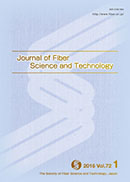- |<
- <
- 1
- >
- >|
-
シクロヘキサンと酢酸エチル中におけるセルロースナノチューブ宇都 卓也, 湯井 敏文2018 年 74 巻 8 号 p. 171-176
発行日: 2018/08/10
公開日: 2018/08/20
ジャーナル オープンアクセスNanotubes are remarkable nanoscale architectures for a wide range of potential applications. Recently, we have predicted a nanoscale, tubular structure of cellulose molecules (CelNT), through density functional theory (DFT) calculation. In the present paper, we report a molecular dynamics (MD) study of the theoretical CelNT models to evaluate their dynamic behavior in solution (cyclohexane or ethyl acetate). Based on the one-quarter chain staggering relationship predicted by DFT calculations, we constructed six CelNT models by combining the two chain polarities (parallel (P) and antiparallel (AP)) and three symmetry operations (helical right (HR), helical left (HL), and rotation (R)) to generate a circular arrangement of molecular chains. The tubular structure of the CelNT models quickly collapsed in ethyl acetate with cleavage of intermolecular hydrogen bonds, indicating that ethyl acetate was not appropriate for the solvent of CelNTs. The four models (P-HR, P-HL, P-R, and AP-R) retained the tubular form in cyclohexane and the P-R and AP-R models exhibited relatively continuous tubular forms with the largest binding energies. The structural features of the CelNT models in cyclohexane were characterized in terms of intermolecular hydrogen bond and the hydroxymethyl group conformation. Solvent structuring clearly occurred, suggesting that the CelNT models may stably disperse in cyclohexane.
抄録全体を表示PDF形式でダウンロード (3651K) -
京谷 陸征, 藤野 謙一, 今井 大介, 後藤 至誠2018 年 74 巻 8 号 p. 177-185
発行日: 2018/08/10
公開日: 2018/08/20
ジャーナル オープンアクセスPaper is composed of plant fibers obtained from both wood and non-wood pulp, and the chemical component is mainly cellulose. It is well-known that cellulosic materials are very hard to carbonize at high temperatures because they decompose thermally before forming carbon materials. We have tried chemical carbonization of wood-pulp paper without thermal decomposition using a catalyst to prepare two-dimensional carbon materials. Three kinds of paper (called LBKP-papers here after) made from bleached kraft hardwood pulp having 0.7~0.76 mm in length weighted mean fiber length and about 260 μm in thickness was used for the chemical carbonization in this work. In the three kinds of LBKP-papers, one includes a wet paper strengthening agent and another one has a little different distribution of the fiber length. One of organic sulfonic acids, methane sulfonic acid (MSA) was used as a catalyst for the carbonization. The LBKP-papers were treated in 1 mol MSA aqueous solution for 5 min and were dried at room temperature. The MSA-treated LBKP-papers were carbonized at 800℃ under an Ar gas atmosphere. Structural and physical properties of carbonized LBKP-papers were investigated. All of the LBKP-papers carbonized at 800℃ were amorphous and then were crystallized with heat-treatment at higher temperatures, being independent of the wet paper strengthening and the different fiber length distribution. A graphitic structure was developed in carbonized LBKP papers heat-treated at temperatures higher than 2000℃. Mechanical and electrical conductive properties of the carbonized LBKP papers were improved with the heat-treatment.
抄録全体を表示PDF形式でダウンロード (3901K) -
Risa Yasoshima, Takeharu Tajima, Hideaki Yamaguchi, Toshifumi Ikaga, Y ...2018 年 74 巻 8 号 p. 186-195
発行日: 2018/08/10
公開日: 2018/08/20
ジャーナル オープンアクセスBy laser beam irradiation of laser-heated drawing, running fiber can be heated rapidly and uniformly. By applying laser-heated drawing to sea-island-type conjugated-spun fibers of syndiotactic polystyrene (sPS) and poly(ethylene terephthalate) (PET), sPS nanofiber and nanofiber powder were fabricated after extraction of the PET component. The PET/sPS conjugated-spun fibers could be laser-drawn stably at the glass transition temperature of each component polymer. By drawing at the glass transition temperature of sPS, the sPS island fibers could be drawn continuously and the sPS component in the drawn fibers indicated a higher crystal orientation than the PET component. The sPS nanofiber bundles had a strength of approximately 300 MPa and sPS nanofibers with an average diameter of 0.43 µm were obtained after extraction of the PET component. By drawing at the glass transition temperature of PET, the fiber could be drawn to a higher draw ratio if the PET fraction was high, but the sPS island fibers were broken into small pieces. As a result, sPS nanofiber powders with a length almost 24 times of their diameter were obtained by extracting the PET component after drawing. The 0.5 µm diameter and 12 µm length were the minimum sizes of the obtained nanofiber powder.
抄録全体を表示PDF形式でダウンロード (5006K)
- |<
- <
- 1
- >
- >|
